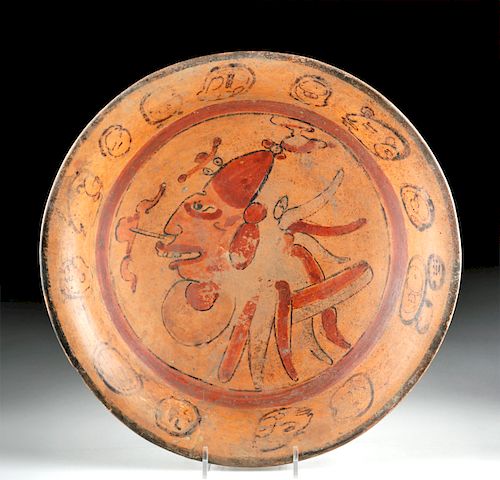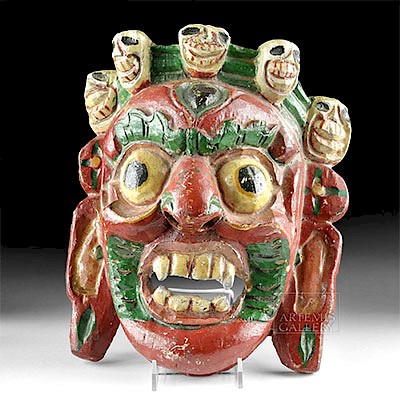Maya Polychrome Plate - Head of Lord
Lot 21a
About Seller
Artemis Fine Arts
686 S Taylor Ave, Ste 106
Louisville, CO 80027
United States
Selling antiquities, ancient and ethnographic art online since 1993, Artemis Gallery specializes in Classical Antiquities (Egyptian, Greek, Roman, Near Eastern), Asian, Pre-Columbian, African / Tribal / Oceanographic art. Our extensive inventory includes pottery, stone, metal, wood, glass and textil...Read more
Estimate:
$800 - $1,200
Absentee vs Live bid
Two ways to bid:
- Leave a max absentee bid and the platform will bid on your behalf up to your maximum bid during the live auction.
- Bid live during the auction and your bids will be submitted real-time to the auctioneer.
Bid Increments
| Price | Bid Increment |
|---|---|
| $0 | $25 |
| $300 | $50 |
| $1,000 | $100 |
| $2,000 | $250 |
| $5,000 | $500 |
| $10,000 | $1,000 |
| $20,000 | $2,500 |
| $50,000 | $5,000 |
| $100,000 | $10,000 |
| $200,000 | $20,000 |
About Auction
By Artemis Fine Arts
Apr 25, 2019
Set Reminder
2019-04-25 10:00:00
2019-04-25 10:00:00
America/New_York
Bidsquare
Bidsquare : Pre-Columbian | Tribal | Ethnographic
https://www.bidsquare.com/auctions/artemis-gallery/pre-columbian-tribal-ethnographic-4035
Featuring ancient and ethnographic art from around the world, including Pre-Columbian, Native American, African / Tribal, Ethnographic, Spanish Colonial, Fossils, Fine Art, much more. Artemis Fine Arts info@artemisfinearts.com
Featuring ancient and ethnographic art from around the world, including Pre-Columbian, Native American, African / Tribal, Ethnographic, Spanish Colonial, Fossils, Fine Art, much more. Artemis Fine Arts info@artemisfinearts.com
- Lot Description
Pre-Columbian, Highlands (Chiapas, Mexico, Guatemala, Honduras, and El Salvador), Maya Late Classic Period, ca. 600 CE. A flare-rimmed dish that would have once stood on three short legs, featuring a painted central portrait head in tondo. The head faces left and depicts someone with an enormous cape and pectoral. The face is classically Mayan, with a prominent nose and very long, sloping forehead, representing beauty ideals that real Mayan lords seem to have cosmetically altered themselves to achieve. Feathers and a topknot rise upward and outward from the face and head. Around the central portrait, on the sloping sides of the rim, are a series of glyphs. Bright colors mark the interior, while the glyphs are all done with steady, black brush strokes. Size: 11.85" W x 2.4" H (30.1 cm x 6.1 cm)
Painted Maya pottery like this was used for feasting, ritual purposes, and as prestigious gifts given to emphasize the power of the giver and bind the recipient to them through a form of purchased loyalty. Maya kings and queens might give them to local governors. The artists who created them were also often minor royalty or nobility, especially the ones who could paint glyphs - literacy was likely reserved for the Mayan elite.
Provenance: private California, USA collection
All items legal to buy/sell under U.S. Statute covering cultural patrimony Code 2600, CHAPTER 14, and are guaranteed to be as described or your money back.
A Certificate of Authenticity will accompany all winning bids.
We ship worldwide and handle all shipping in-house for your convenience.
#145702Hairline crack from rim that has been repaired/restored with overpainting along the repair line. All three tripod legs are lost. Otherwise in nice condition with generally well preserved motifs and pigment.Condition
- Shipping Info
-
All shipping is handled in-house for your convenience. Your invoice from Artemis Gallery will include shipping calculation instructions. If in doubt, please inquire BEFORE bidding for estimated shipping costs for individual items.
-
- Buyer's Premium



 EUR
EUR CAD
CAD AUD
AUD GBP
GBP MXN
MXN HKD
HKD CNY
CNY MYR
MYR SEK
SEK SGD
SGD CHF
CHF THB
THB















